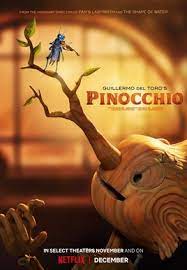
PINOCCHIO/ GUILLERMO DEL TORO'S PINOCCHIO
US, 2022, 117 minutes, Colour.
Voices of: Gregory Mann, Ewan McGregor, David Bradley, Ron Perlman, Finn Wolfhard, Cate Blanchett, Francesca Fanti, Burn Gorman, Tim Blake Nelson, Tilda Swinton, John Turturro, Christophe Waltz.
Directed by Guillermo del Toro, Mike Gustafson.
Another Pinocchio? Well, not exactly. This version has the director’s name in the title. Del Toro is Mexican but has been very successful in films in the United States, Nightmare Alley, Shape of Water, to Hellboy films, as well as the Spanish classic, Pan’s Labyrinth. It is clear that he likes working in imaginative stories and treatments.
While the familiar story of Pinocchio is present throughout this film (without the story of the lost boys and their turning into donkeys), this version is very idiosyncratic and distinctive. First of all, it is stop-motion animation, striking characters, situations, action, but often with a very dark and grim tone. And the director has assembled a very strong voice cast, young Gregory Mann as Pinocchio, veteran actor, David Bradley, as Gepetto. Ewan McGregor does the commentary as Jiminy cricket. (And, the baboon character, Assistant to Count Volpe (a sinister Christophe Waltz) with his travelling show, has only strange sound utterances, from Cate Blanchett!).
Audiences will be taken aback immediately when they learn that the action begins in 1916, during World War I, Gepetto working with his beloveds son, Carlo, woodwork, carving, and a giant crucifix for the local church (and quite a number of Catholic references). planes flying over, bombs dropped, Carlo is killed. Gepetto goes into decline – but he does carve his puppet, Pinocchio. There is the dream where the Blue Fairy gives the gift of life to Pinocchio (which means that if he experiences death, he comes to life again). And Jiminy Cricket, more serious, perhaps, than usual, is there as Pinocchio’s conscience and guide as well is the narrator of the film.
The action now takes place during the fascist years of Mussolini (who also comes to the circus to see the puppet but receives some comeuppance!). The sinister Count Volpe controls Pinocchio and his performances with a contract. In the meantime, the fascist leader of the town demands that Pinocchio go to school. We are familiar with what happens to Pinocchio but this continues over a long period, the count becoming more exploitative, the baboon and the other puppets becoming more friendly, and Gepetto searching for his son and being swallowed by the huge sea-beast.
So, it is a strange experience, watching this story of Pinocchio and Gepetto during World War I, the fascist era in Italy, moving towards World War II (the same time as Disney’s original film, 1940, was screening round the world).
The theme of father and son is strong. The important message of telling lies – and Pinocchio’s branch-like extending nose is quite striking – is significant. There are a lot of funny slapstick scenes, especially involving Jiminy cricket. And there are some songs, especially on the theme of father and son.
This version of Pinocchio is not really geared towards a children’s audience, nor, necessarily, a family audience. Attentive younger audiences will find it intriguing. As will an increasingly curious adult audience.
- The popularity of the story of Pinocchio? Italian origins? The Disney film of 1940? Images, characters, songs? Further versions? Roberto Benigni, Tom Hanks?
- The range of the voice cast, variety of accents, producing sounds?
- The work of the director, his career, Mexican background, his interest in fantasy?
- The visual style, stop-motion animation, puppets and characters, backgrounds, home, the circus, the sea, the sea beast? The songs and their focus, on Pinocchio, on family?
- The Italian settings, 1916, the war, the planes unloading their bombs, Carlo’s death? The action continuing throughout Mussolini’s fascist era, the fascists and their control, Mussolini coming to the circus, his being mocked? The impact of this setting in interpreting Pinocchio?
- Geppetto, carving, the crucifix and the emphasis on Catholic imagery throughout the film? Carlo helping? The war, the bombs, Carlo going back into the church, his death? The effect on Geppetto?
- The consequences for Geppetto, in mourning, his decision to carve, forming Pinocchio? The substitute son? Grief, drinking? The blue fairy arriving, the wish for Pinocchio, coming alive?
- The role of Jiminy Cricket, more serious, yet the pratfalls comic sequences, his responsibility, Pinocchio’s conscience, the issue of school, the issue of the circus, his being the victim, forever squashed? Get perseverance, supportive of Geppetto?
- Count Volpi, personality, exploitative, his circus, Spazzatura, servant, victim, advice to the count?
- Pinocchio, going to school, the fascist authority in the town demanding, the temptation by the count, wanting to be important? The years of being in the circus, with the other puppets, without strings, his songs and the plaintiff tone, the contract with the Count, signing, unbreakable?
- The issue of lies and honesty, Jiminy Cricket’s conscience, Pinocchio and his lies – and the device of having his ever lengthening nose looking like a branch?
- Geppetto, his grief, going in search of Pinocchio? The experience on the water, swallowed by the sea beast? The beast, appearance, size, and Jiminy Cricket in the beast?
- The audience, the success, the effect on Pinocchio, the significance of his not being able to die, the various experiences of death, the Queen, the sand going through the flask, his various resuscitations?
- Spazzatura, reacting against the Count, helping Pinocchio? Pinocchio, the realizations, the escape? On the sea, swallowed by the sea beast?
- Geppetto, Jiminy Cricket, surviving, the arrival of Pinocchio, banding together, the devices for their escape?
- The future, Pinocchio and his experiences, his love for Geppetto, becoming a true boy, true son?